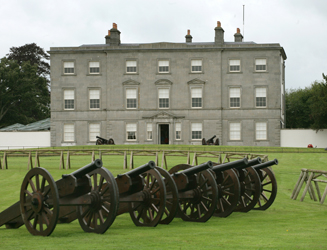Saturday 22nd. February 2014. (Ian Adamson was our historical tour guide all day).
- 09:00am – Bus pick up at Derryhill shops, Rathcoole.
- 09:15am – Bus pick up at Crues. football club, Shore Road.
- 11:00am – Tour of Battle of Boyne site, Co. Meath. (Visitor centre, Battlefield, Boyne River with private guide).
- The Battle of the Boyne between King William III and his father-in-law, King James II, was fought on 1st July, 1690 (11th July according to our modern calendar, so that Bonfire Night celebrates the Battle of the Boyne and Orangeman’s Day, 12th July, the whole of the glorious Revolution, the final victory at the Battle of Aughrim being on 12th July, 1691). Both kings commanded their armies in person, 36,000 on the Williamite side and 25,000 on the Jacobite side – the largest number of troops ever deployed on an Irish battlefield. At stake were the British throne, French dominance in Europe and power in Ireland. The Battle of the Boyne Visitor Centre is located in the recently restored 18th century Oldbridge House, which is on the battlesite. There is free access to the battlesite, parklands and the formal gardens.


Battle of the Boyne Site
Where William of Orange defeated King James II in 1690.
- 12:30pm – Three course set lunch with tea/coffee at the Tea Pavillion on site. (Veg soup, Chicken & Garlic with baby potatoe, apple pie & custard).
- 01:00pm – Bus pick up.
- 01:15pm – Tour of Francis Ledwidge Museum & Gardens, Slane, Co.Meath. (Known as poet of the Blackbird who was killed in action at Ypres WW1).
The Ledwidge Cottage Museum commemorates the Irish poet, political activist, nationalist and war hero Francis Ledwidge (1887-1917). The cottage is the family home where Ledwidge was the eight of nine children who grew up in poverty. Ledwidge worked a variety of menial jobs before he attracted the patronage of Lord Dunsany. He joined the Irish Volunteers and went on to fight with the British Army in World War I. His poetry expresses his longing for home and his disillusionment after experiencing the horrors of war while Irish nationalist rebellion stirred in Ireland. Before he could return home to play his part in the new Ireland that was emerging, Ledwidge, along with five other enlisted men, were killed by a shell while repairing a road near Ieper (Ypres), Belgium. - 02:00pm – Bus pick up.
- 02:15pm – Tour of Slane Hill, Slane village. (Slane Hill is named after an ancient king buried here & St. Patrick lit the first paschal fire here).

The Hill of Slane is predominantly steeped in Christian history and myth. St Patrick is traditionally believed to have lit the first paschal fire on the hill in defiance of the pagan High King Lóegaire. The king, who resided at Tara, forbid any other fires being lit within view of Tara during the Beltaine Festival (Spring Equinox). In Muirchú Moccu Mactheni’s highly mythicized 7th century Life of Patrick, Lóegaire is described as “a great king, fierce and pagan, emperor of the barbarians”. After a number of attempts by Lóegaire and others to kill Patrick, Lóegaire is warned by the saint that he must accept the faith or die. Having taken the counsel of his people, he submits and is baptised. St Erc was believed to be a pagan druid converted by Patrick and appointed first Bishop of Slane. Erc is believed to have trained St Brendan the Navigator at his church in Tralee, and ordained him priest in 512 AD. St Brendan is one of the 12 Apostles of Ireland.
But even before the establishment of the ancient monastery, the hill had a pre-Christian history. The warrior and Fir Bolg King Slaine met his death upon this hill and is believed to have been buried here. Slaine may well have been a Belgic king of British origin. A mound, now known as “The Motte” and currently blocked from view by trees and blockaded from approach by fencing, is most likely over his grave. This mound may have been converted to a motte by the Norman Richard Fleming in the 1170s. The Bailey was abandoned when the Flemings moved to Slane Castle. The Flemings reconstructed the monastic site for the Franciscans in the 16th century. East of the mound is a ring-barrow which could also be the burial place of Slaine.